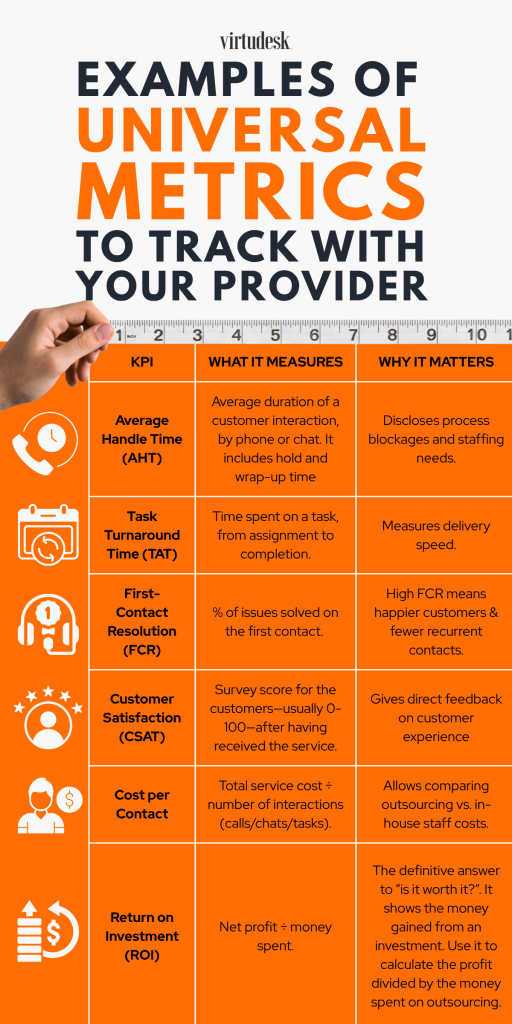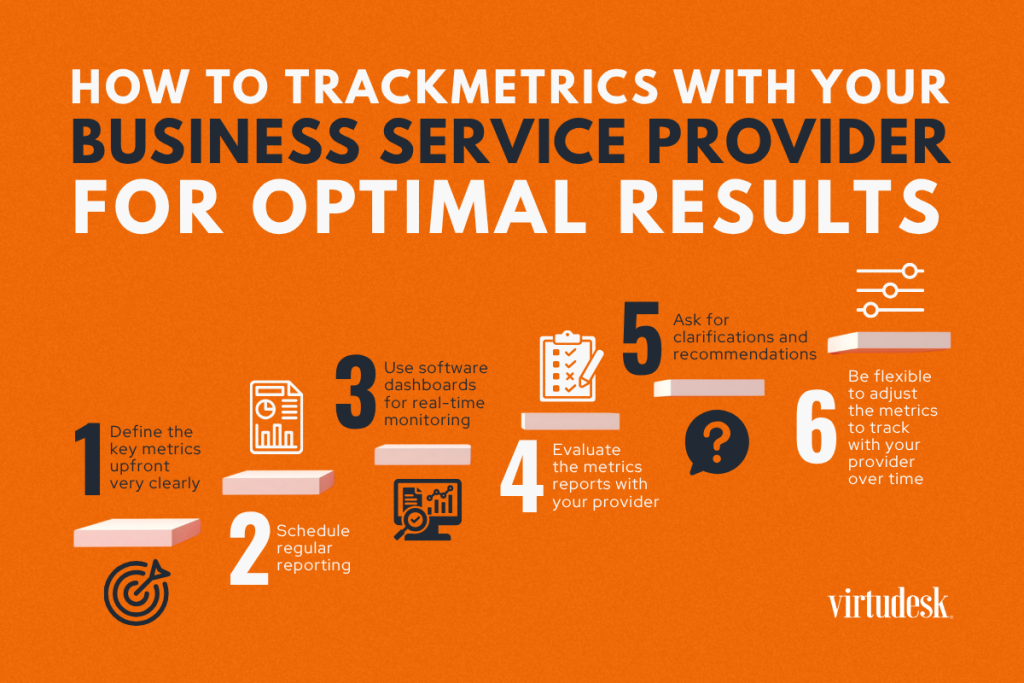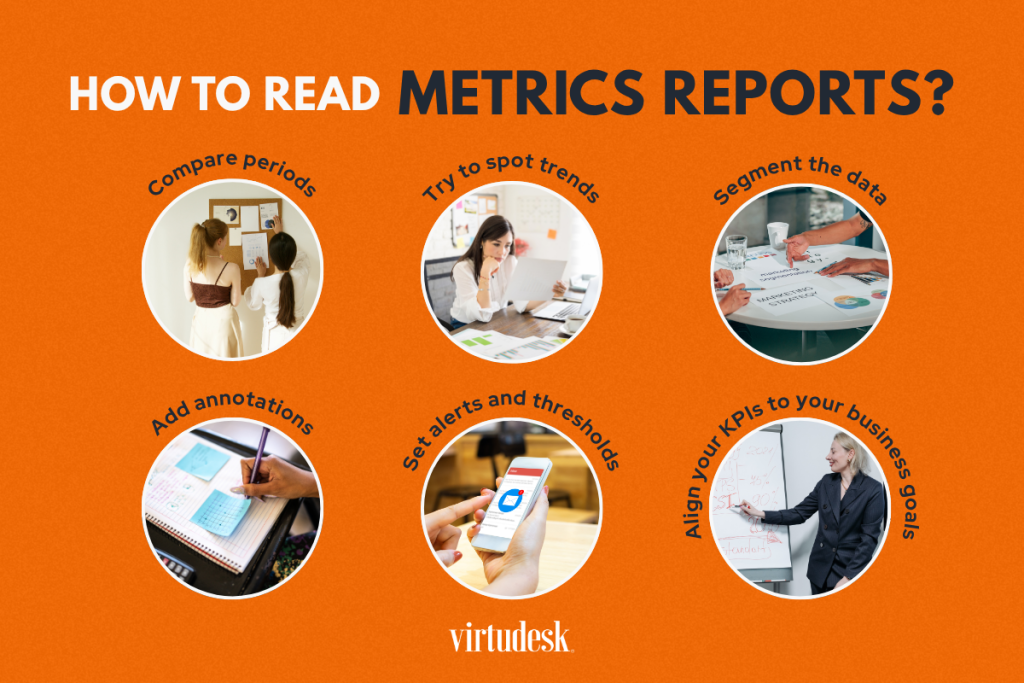Performance That Scales: Key Metrics for Business Service Providers
Introduction
Outsourcing is the answer to rational, smart business development, and from solopreneurs to big corporations, picking the correct partner becomes a growth tool if you track key metrics for business service providers.
This time, we’ll examine the essential KPIs (key performance indicators) that indicate performance, spot improvement areas, and help your business improve.
Some of the metrics to check with your business provider are universal, others role-specific. Likewise, some are basic ones you should ensure to track, and others are optional.
You need to know how to distinguish which metrics are the essential ones you need to track with your outsourcing service provider, and which supplementary ones you could eventually monitor as well to get broader insights.
Let’s talk about metrics today: what they are, what universal (general) or role-specific metrics are, what they reflect, and how to work with them to get the best results.
At Virtudesk, we know that transparency and accountability are essential elements for a fruitful working partnership. That’s why we’ll continuously keep an eye on your remote team’s performance. We use Timedly, our exclusive tracking and reporting tool, which you can access anytime as well, along with other commonly used platforms.
If you are not into numbers, statistics, and percentages, the terms tracking and analyzing metrics might sound like having to solve a complex puzzle. Keep on reading, and you’ll realize how, with some key concepts, tools, and a serious business service provider, they will become a priceless yet easy aspect to handle to achieve your objectives faster.
Metrics vs. KPIs: What’s the Difference?
A metric is any quantifiable data you track (such as phone calls handled or hours logged in the system). A Key Performance Indicator (KPI) is a metric tied to a specific business goal, such as client retention, revenue, or cost savings.
PennState, (Planning, Assessment and Institutional Research) states that “a KPI measures the organization’s progress towards its goals, while metrics measure the tangible steps towards completing its strategy”.
Key Takeaway: All KPIs are metrics, but not all metrics are KPIs.
Universal Key Metrics for Business Service Providers vs. Role-Specific KPIs
There are two main categories of key metrics for business service providers or business managers.
- Universal KPIs: These apply throughout all services and duties within your company or team and give you awareness of the overall performance.
- Role-specific KPIs: These are linked to specific functions and let you regulate your team members’ work for that role.
Key Takeaway: Universal metrics tell you if outsourcing is beneficial; role-specific metrics tell you where and how to make it even better.
Examples of Universal Metrics to Track with Your Provider
Monitor universal metrics or KPIs across all your outsourced operations. These universal metrics reveal, among other factors, efficiency, customer satisfaction, and profitability. This permits and simplifies making rapid modifications before minor problems corrode your business progress (and your partnership with your service provider).

These key metrics for business service providers are valid for any outsourced function (from administrative, technical, to customer support). They give you invaluable acumen to assess the performance of your outsourced team.
Key Takeaway: Monitoring these universal metrics exposes efficiency, customer satisfaction, and profitability, enabling quick adjustments before minor issues corrode your partnership’s value.
Examples of Role-Specific KPIs You Should Track
Once you are tracking the universal KPIs, it’s time to implement metrics that are specific to a service or role.
Achieving success in different roles has many things in common. For example, regardless of the task, a well-done job involves managing time, ensuring customer satisfaction, and maximizing return on investment. However, the different roles may require other metrics.
At Virtudesk, we monitor general, universal metrics and also emphasize monitoring the metrics of our staff role-related ones. This is our way to guarantee that all the services we provide maintain the same high quality across the different functions.
Let’s review some examples of key metrics to track with your business service provider, depending on the functions.
- Virtual Assistants (VAs) and Admin Services
At Virtudesk, we track both general and role-specific metrics for our VAs, and that’s what any serious service provider should do.
- Task Turnaround Time: It measures how fast tasks are completed. Both speed and reliability are crucial here.
- Tasks Completed per Hour: It shows productivity by dividing the volume of finished tasks by the hours billed.
- Timedly Productivity Score: Our Virtudesk proprietary tracking software measures how effectively employees use their time to achieve work goals and flags idle time instantly. Note that there are other popular tools you could use to track and manage your virtual assistants, too.
- Utilization Rate: It’s the percentage of booked hours actually spent on client work, ensuring you don’t pay for downtime.
- Call Center and Customer Service
For customer-facing roles, these customer service metrics are crucial:
- First-Contact Resolution (FCR): Reflects the % of issues solved on first interaction. It’s key to have fewer repeats and get higher client loyalty.
- Average Handle Time (AHT): Shows the average interaction length with clients. Useful to lower costs while maintaining quality.
- Customer Satisfaction (CSAT): It’s the result of post-call survey scores that reflects direct customer sentiment.
Note that there are various ways to calculate the CSAT, for example, unhappy to happy faces, thumbs-up and thumbs-down system, or 5 star ratings, as Greg Raileanu, founder & CEO at Retently explains in more depth.
- Service Level Agreement (SLA) Adherence: It shows the compliance with the terms of the contract between the service provider and the customer. It includes the levels of service that will be given and the metrics to achieve.
- Cost per Contact: This metric mirrors the total costs divided by the number of contacts and demonstrates financial efficiency.
- Marketing, Design and Branding
Creative and marketing teams need focused metrics:
- Campaign ROI: It’s the division of revenue or leads by campaign costs and shows how creative work can help you obtain more gains.
- Project Delivery Time: It tells how many days it took the staff to deliver the final assets since they received the initial brief.
- Brand-Consistency Score: This metric measures the percentage of assets that pass brand quality assurance (QA) testing.
If you’re interested in marketing metrics, check out our post on 35 marketing metrics to watch for your business.
- Team Management
Managing remote teams requires clarity and control. These are some of the specific key metrics for business service providers should track:
- On-Time Delivery Rate: Shows the percentage of projects delivered on schedule. Not meeting the deadline affects revenue and the client’s trust.
- QA Pass Rate: It refers to the percentage of tasks that pass a quality test on the first try. It demonstrates work quality and adequate processes.
When it comes to team management, versatility is fundamental. At Virtudesk, we are ready to help you manage any size of remote team, keep strict monitoring, and share with you comprehensive weekly reports.
Let’s monitor and improve your remote employees' performance together. Find out how at our team management services page.
Key Takeaway: The use of role-specific metrics exposes inefficiencies and recognizes high performers, significantly empowering continuous improvements across the different outsourced roles.
Why Do Metrics Matter in Outsourcing?
Keeping track of KPIs proves ROI, detects quality gaps early, and aligns every employee with bottom-line goals.
According to Deloitte’s Global Outsourcing Survey, 2024, cost reduction is still one of the top reasons why companies outsource, but talent and agility rank equally high. And that’s precisely why metrics are so significant when outsourcing to a business service provider. Metrics reveal the competence and productivity of the outsourced personnel. Furthermore, they help spot any areas of improvement and growth.
Key Takeaway: KPIs are metrics that give business owners and managers insight into how their business or a specific area of it is working at a point in time.
What Are KPI Reports and How to Work with Them?
A KPI report is a digital or physical document that keeps track of and analyzes the progress of determined measurable values compared to predefined goals.
They can also be dashboards within KPI reporting software such as Qlik. To view a list of other popular KPI tools to track your metrics with your service provider, access these 14 recommendations from Business.com.
How to Track Metrics with Your Business Service Provider for Optimal Results
You need to ensure your outsourcing service provider is delivering real value and transparency. Follow these practices for a flawless partnering:

- Define the key metrics upfront very clearly. Determine which ones matter most and align with your goals.
- Schedule regular reporting. For example, ask for weekly reports for fast-moving functions or monthly reports for slower cycles.
- Use software dashboards for real-time monitoring. Explain to your provider the information you want to view easily.
- Evaluate the metrics reports with your provider. Check together what’s functioning, what can be improved, and adjust the strategies as needed.
- Ask for clarifications and recommendations. If you don’t understand why a KPI changed, ask. Want to know how to improve something? Ask.
- Be flexible to adjust the metrics to track with your provider over time. Bear in mind that as your business evolves, so should your KPIs.
Key Takeaway: Agree on KPIs early, demand transparent report or dashboards, and schedule recurring reviews. Ask clarifying questions, request improvement recommendations, and adjust metrics as objectives evolve.
How to Read Metrics Reports?
Interpreting reports implies recognizing trends and identifying anomalies.
So your business service provider shared with you the reports as agreed. Now, how can you interpret them? Follow these tips below:

- Compare periods. Compare current figures to prior weeks or months, last year’s same timeframe, and industry benchmarks.
- Try to spot trends. Try to identify patterns over time, as a single low or high value may be an outlier.
- Segment the data. Classify the KPIs. For example, categorize them by traffic source, device type, new or returning audience, campaign or landing page.
- Add annotations. Add side notes to explain events or facts that can have impacted the metrics, such as website updates, marketing campaigns, or seasonal changes.
- Set alerts and thresholds. Determine, for instance, which are your acceptable performance ranges or set warnings when KPIs drop down or go up.
- Align your KPIs to your business goals. Always question yourself if a certain metric aligns with your business objectives. If not, consider not tracking it anymore.
Key Takeaway: To read your reports, compare periods, segment data, and add notes explaining why some figures changed. Differentiate anomalies from trends and link KPIs changes to initiatives.
Frequently Asked Questions (FAQs)
Q1: What are the most important KPIs for business service providers?
A: The most important KPIs include First-Contact Resolution (FCR), Customer Satisfaction (CSAT), Task Turnaround Time (TAT), Cost per Contact, Return on Investment (ROI), and Utilization Rate. These differ depending on the service type.
Q2: Why should I track metrics with my outsourcing provider?
A: Tracking metrics guarantees transparency, detects inefficiencies, corroborates ROI, and improves informed, data- driven decision-making.
Q3: What is the difference between a metric and a KPI?
A: A metric is a measurable, quantifiable data point, while a KPI is a metric directly linked to an objective. For example, "calls handled" is a metric, while "calls handled per hour" is a KPI if it relates to productivity objectives.
Q4: Can I ask my provider for custom-created metrics?
A: Yes. Most providers, including Virtudesk, offer customizable tracking and reporting. Discuss your goals with your provider to identify which metrics will be more relevant for your business purposes.
Q5: What tools does Virtudesk use to track metrics?
A: We use an assortment of branded tools like Timedly and industry-related standard platforms to track productivity, quality, and customer satisfaction in real time.
Final Thoughts
Keeping track of the correct KPIs guarantees that your outsourcing partnership with your business service provider brings you measurable added value. From universal indicators like ROI and FCR to role-specific metrics like utilization rate and project delivery time, each one plays a role when it comes to growing your business with utmost efficiency.
At Virtudesk, we don’t just track figures and percentages; we transform apparently simple numbers into actionable insights that result in real and measurable growth.
Get in touch with us to learn how Virtudesk ensures transparency, performance, and progress through data-driven outsourcing. Schedule a free discovery call, or call us at +1 (800) 470 8136, and our representatives will be delighted to explain to you all we can do for your business growth based on smart management through data-based insights.
Share this article
Meet our Most Trusted
Partners & Clients

Byron Lazine
Co-Founding Chief-of-Operations at BAM (Broke Agent Media)I’ve been using Virtual Assistants for years throughout all of my companies. Once we found Virtudesk the process got even easier and allowed us to scale out our hiring. Highly skilled and accountable professionals. 100% recommend!

Rebecca Julianna James
Realtor / Content CreatorBefore getting started with Virtudesk I had my doubts that they would find what I was looking for. I needed a very particular person to add to my team and let me tell you I am highly pleased! My virtual assistant Myril is the best! I am excited to grow my socialmedia accounts with her. Thank you Virtudesk!

Chelsea Erickson
Realtor La Belle RE GroupI am very happy with the assistance Virtudesk is providing for my real estate business. This is a newer position for my company and we are working through the creation and efficiency.

















